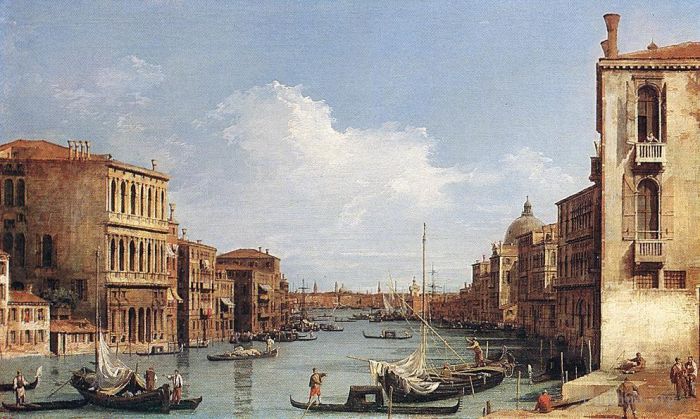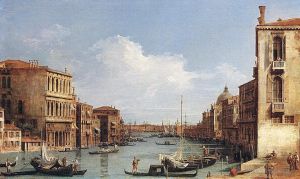The Grand Canal looking East from Campo San Vio towards the Bacino
Canaletto
- Price: Price on Request
- Art Type: Oil Painting
- Size:
- English Comments: 0
- International Comments: 0
- Creating Date:
- Introduction and Works of Canaletto >>
Work Overview
- The Grand Canal looking East from Campo San Vio towards the Bacino
Canaletto
Date: c.1730; Venice, Italy *
Style: Baroque
Genre: veduta
Media: oil, canvas
Dimensions: 47.6 x 79.5 cm
Location: Private Collection
This view is dominated by the Palazzo Barbarigo. Canaletto focusses here on the different textures and colours of the ageing and weather-beaten plaster, which provide a backdrop for small vignettes of daily life.
This is one of a series of twelve views by Canaletto of the Grand Canal which are all the same format. The pictures form the basis of the fourteen engraved plates in Visentini's 'Prospectus Magni Canalis Venetiarum' (Venice, 1735), thus providing an uncontested date for completion. It is thought that they originated in the years around 1730. The paintings were all acquired by George III with the collection of Consul Smith.
The Campo (or Campiello) San Vio opens on to the Grand Canal at a point a hundred metres east of the Carità, and this view thus repeats some of the buildings shown in the previous painting. The church of San Vio, properly Santi Vito e Modesto, is out of picture to the right of this view, and was demolished in 1813. The right side of the painting is taken up by the flank of Palazzo Barbarigo, with the gothic façade of Palazzo da Mula in sharp foreshortening beyond. The dome of the Salute protrudes above the Palazzi Dario, Barbaro and Benzon. This view is impossible from the narrow campo: Canaletto has expanded the foreground and incorporated a view of the right bank taken from a little way into the canal.
The left bank of the canal is dominated by Palazzo Corner della Ca' Grande, built after 1533 to Sansovino's designs. Beyond are Palazzi Minotto and Gritti, and finally the tall Palazzo Flanghini Fini. On the horizon are the belltowers of San Martino (left) and San Biagio (right), with the dome and tower of San Pietro di Castello in between. Perhaps surprisingly, given that no celebrated building other than Palazzo Corner is seen well, this was one of the most popular compositions of Canaletto's whole career, and many versions are known.
- Copyright Statement:
All the reproduction of any forms about this work unauthorized by Singing Palette including images, texts and so on will be deemed to be violating the Copyright Laws.
To cite this webpage, please link back here.
- >> English Comments
- >> Chinese Comments
- >> French Comments
- >> German Comments
- >>Report
- Capriccio with ruins and porta portello in padua
- The women s regaton the grand canal
- The campo di rialto
- The Eastern Facade Of Warwick Castle
- Riva degli Schiavoni west side
- The piazzetta towards san giorgio maggiore
- Doge Palace
- Santa Maria Zobenigo
- Grand Canal
- San Giacomo Di Rialto
- The Piazzetta
- Capriccio with classical ruins and buildings
- Grand Canal From Santa Maria Della Carita To The Bacino Di San Marco
- Basilica di vecenza and the ponte de rialto
- Capriccio of a round church with an elaborate gothic portico in a piazza a palladian piazza and 1755
- Piazza San Marco Venice (Piazza San Marco with the Basilica)
- The Nave of San Marco looking East (San Marco the Interior)
- Warwick castle
- The Bucintoro Returning To The Molo On Ascension Day
- A Regatta on the Grand Canal
- Venice Viewed from the San Giorgio Maggiore
- View of the Ducal Palace
- Piazza san marco looking east
- The Bacino di San Marco on Ascension Day
- View Of the Entrance To The Arsenal
- Dolo On The Brenta Venetian Venice
- The Molo Looking West
- Palazzo Ducale and the Piazza di San Marco
- Grand Canal The Rialto Bridge From The South
- Scala dei giganti 1765
- The Riva Degli Schiavoni
- Rio Dei Mendicanti
- The interior of henry vii chapel in westminster abbey
- View of the grand walk vauxhall gardens with the orchestra pavilion the organ house the turkish
- Perspective View with Portico
- Stonemasons Yard
- View of the Bacino di San Marco St Marks Basin
- Perspective with a portico 1765
- The thames with st pauls cathedral 1746
- Piazza San Marco 1730
- Reception Of The Ambassador In The Doges Palace
- Dolo on the brenta
- Return Of The Bucentoro To The Molo On Ascension Day
- The chapel of eton college 1747
- The Grand Canal From Rialto Toward The North
- The Grand Canal with the Rialto Bridge in the Background
- View Of Campo Santi Apostoli
- Perspective view with portico
- Capriccio of the grand canal with an imaginary rialto bridge and other buildings
- London Interior of the Rotunda at Ranelagh
- The Grand Canal looking East from Campo San Vio towards the Bacino
- The Fonteghetto Della Farina
- The Piazzetta towards S. Giorgio Maggiore
- The thames and the city of london from richmond house 1746
- Campo san rocco
- Night time celebration outside the church of san pietro di castello
- The Stonemasons Yard
- Canal Giovanni Antonio View Of The Grand Canal And Santa Maria Della Salute With Boats And Figure
- The Piazzetta towards Santa Maria della Salute
- Piazza San Marco The Clocktower
- Capriccio of a renaissance triumphal arch seen from the portico of a palace 1755
- Bacino di San Marco St Marks Basin
- San francesco della vigna church and campo
- Entrance To The Grand Canal Looking East
- Alnwick castle
- Piazza San Marco Looking Southeast
- Westminster abbey with a procession of knights of the bath 1749
- CANALETTO Grand Canal Looking Northeast From Palazo Balbi Toward The Rial to Bridge
- The Feast Day of St Roch
- Arrival of the French Ambassador in Venice
- CANALETTO Grand Canal Looking East From The Campo San Vio
- Capriccio Ruins And Classic Buildings
- The Entrance to the Grand Canal Venice
- A Regatta on the Grand Canal
- English Landscape Capriccio with a Column
- The dogana in Venice (Punta della Dogana in Venice)
- Santi Giovanni E Paolo And The Scuola Di San Marco 1726
- Campo santa maria formosa
- The Piazza San Marco in Venice
- San Cristoforo San Michele and Murano from the Fondamenta Nuove Venice
- The Grand Canal with Santa Maria della Salute looking East towards the Bacino
- Rome the arch of constantine 1742
- Santi Giovanni e Paolo and the Scuola de San Marco
- The Grand Canal near the Ponte di Rialto
- Venice Piazza San Marco and the Colonnade of the Procuratie Nuove









 Singing Palette
Singing Palette